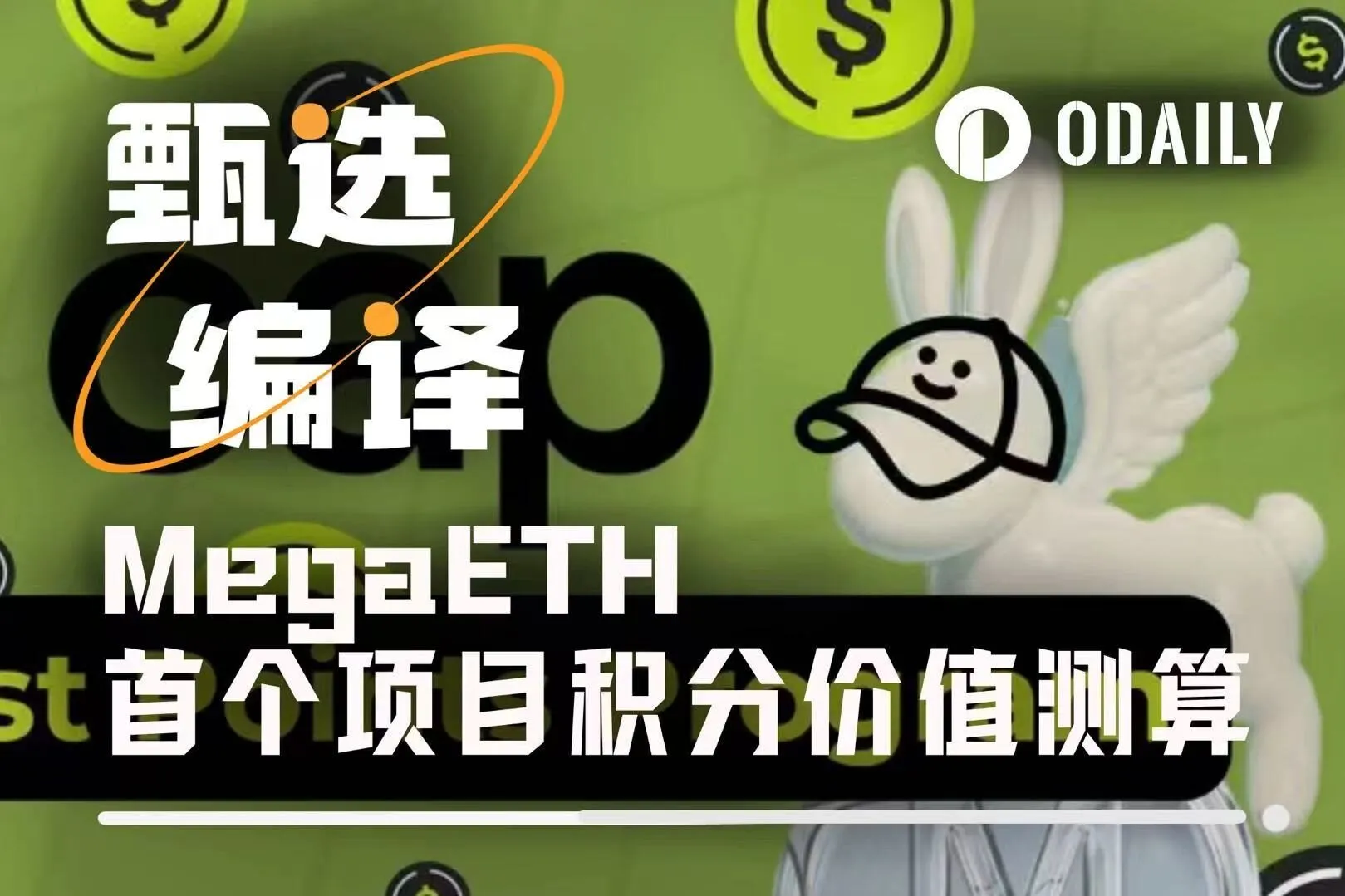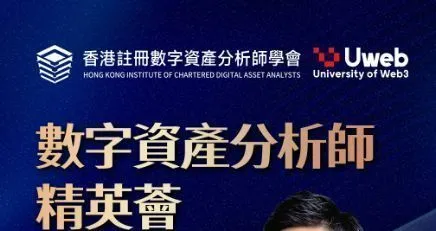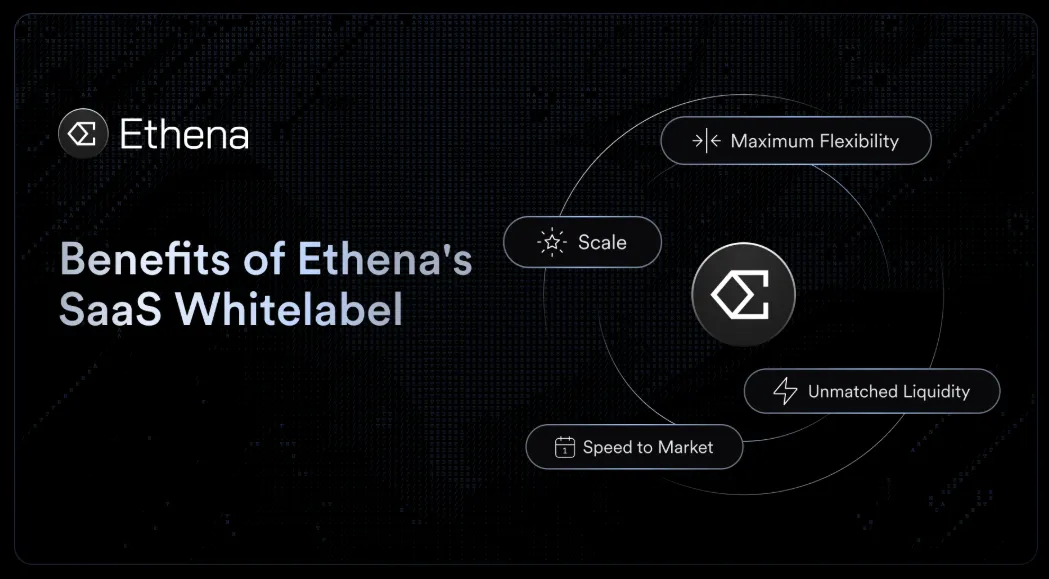When AI Agents begin to possess their own "identification" and "credit records," a decentralized machine economy era is quietly approaching. ERC-8004 is not just another technical standard, but a trust infrastructure at the intersection of AI × Crypto — it allows Agents to break free from platform constraints for the first time and establish verifiable collaborative relationships on the blockchain.
Core Points
- Full Support from the Ethereum Ecosystem: Ethereum is rarely seen pushing its decentralized AI strategy with full force, establishing a dedicated dAI team that garnered over 10,000 social mentions and 8 independent implementations within 24 hours of the standard draft release, receiving joint endorsement from Google, Coinbase, and MetaMask.
- Solving the Trust Dilemma for AI Agents: ERC-8004 builds a decentralized trust layer through three major on-chain registries (identity/reputation/verification), allowing AI Agents to possess a digital identity and credit record that can be migrated across platforms for the first time, breaking the data monopoly of giants like OpenAI and Google.
- Market Direction Focus: As the trust infrastructure for the AI Agent economy, the value of ERC-8004 will not exist in isolation but will be transmitted to related tokens through different layers of the tech stack, making several core beneficiary tokens worth paying attention to from multiple angles.
I. Related Events and Background
1.1 Ethereum's Shift in AI Strategy
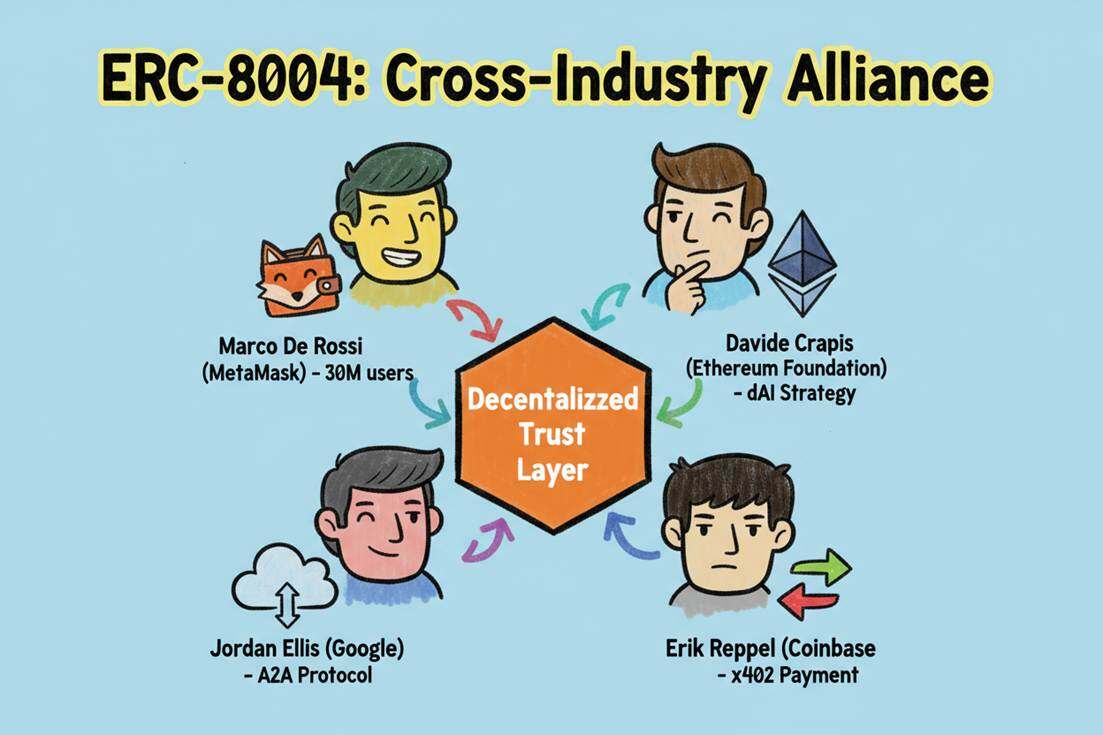
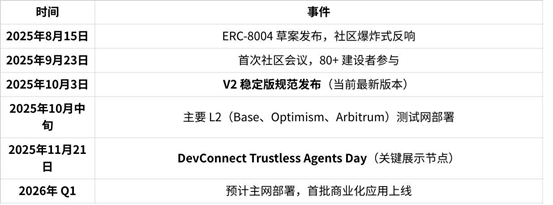
On August 15, 2025, the Ethereum Foundation established the dAI team to promote the ERC-8004 standard, led by core developer Davide Crapis. Within 24 hours of the release, social media saw over 10,000 spontaneous mentions, and 8 independent technical implementations were completed that day, quickly becoming the hottest topic on the Ethereum Magicians forum.
This level of promotion is unprecedented: the first implementations of ERC-20 (2015) emerged months after its release, and ERC-721 (2017) only exploded in the market six months later due to CryptoKitties, while ERC-8004 had 8 independent implementations on the same day, reflecting the urgent market demand for AI × Crypto infrastructure.
Delving deeper, the final signatory list of the ERC-8004 specification reveals a rare cross-industry alliance: MetaMask controls the Web3 entry for 30 million users, the Ethereum Foundation leads the decentralized strategy, the Google Agent-to-Agent protocol team represents traditional tech giants, and Coinbase connects compliant exchanges and payment infrastructure, along with collaborative participation from teams like EigenLayer, ENS, and The Graph.
This combination is extremely rare in Ethereum's history — standard-setting is usually driven from the bottom up by the developer community, with corporate participation often lagging by months. However, ERC-8004 received simultaneous involvement from the wallet layer, exchange layer, and cloud service layer from the draft stage — this means that for the first time, the largest Web3 wallet (MetaMask), traditional tech giant (Google), largest compliant exchange (Coinbase), and the Ethereum Foundation reached a consensus in the AI × Crypto field.
1.2 Why Now?
The emergence of ERC-8004 is not coincidental, but rather a convergence point of three technological waves formed in 2025 — in the two years following the release of ChatGPT, AI has evolved from a conversational tool to autonomous agents. Agents are no longer limited to answering questions; they can perceive their environment, make decisions, and execute tasks — from booking flights to managing investment portfolios. Market research firms predict that the global AI market will reach $1.8 trillion by 2030, with the Agent economy occupying a core position. However, as technology explodes, centralized risks are also gradually accumulating. OpenAI, Google, and Anthropic control the major models, and Agent services are locked within their respective ecosystems, unable to collaborate across platforms, with users' identity and reputation data completely controlled by the platforms and non-transferable.
At the same time, the payment infrastructure of Web3 has matured. The x402 protocol introduces the HTTP 402 payment standard into the cryptocurrency realm, allowing Agents to pay directly with on-chain assets; the AP2 protocol (Agent Payment Protocol) enables automatic settlement between Agents. However, this payment framework lacks a critical component: a decentralized trust layer to verify the identity and credibility of Agents.
ERC-8004 precisely fills this gap, providing the missing trust infrastructure for the existing tech stack.
II. What is ERC-8004?
2.1 The Trust Dilemma of AI Agents
Imagine a scenario: you need an AI Agent to help you analyze stocks, book travel, or manage social media. How do you confirm the authenticity of this Agent's identity? How do you assess its past service quality? How do you verify that it has indeed fulfilled its promised tasks?
In the traditional internet, these issues are resolved by platforms — Taobao provides seller verification and credit ratings, Uber records driver reviews, and banks verify transaction completions. However, this approach centralizes trust in a single entity, leading to three systemic risks: platforms can arbitrarily ban accounts (in 2023, OpenAI banned thousands of API accounts for policy reasons), users cannot transfer their reputation to other platforms (your five-star rating on Taobao is worthless on Amazon), and the verification process is opaque and un-auditable (algorithmic black boxes leave users unable to assess the actual performance of Agents).
ERC-8004 offers a decentralized alternative. It stores the three core elements of identity, reputation, and verification on the blockchain, achieving a public credit infrastructure where "anyone can read and verify, but no one can tamper with or delete." This is not a simple technical upgrade, but a fundamental shift in the trust model — from "trust the platform" to "verify the facts."
2.2 The Working Mechanism of the Three Registries
The ERC-8004 standard is built on the Agent-to-Agent (A2A) communication protocol open-sourced by companies like Google, and it complements the original A2A protocol by adding the missing decentralized trust layer through three core registries. 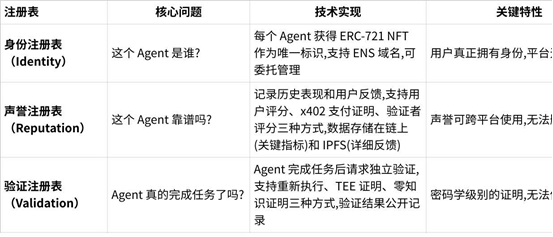
2.3 Operational Case
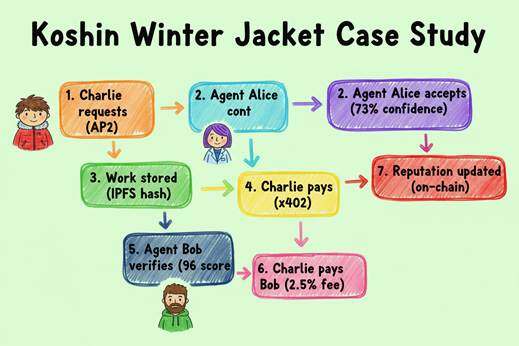
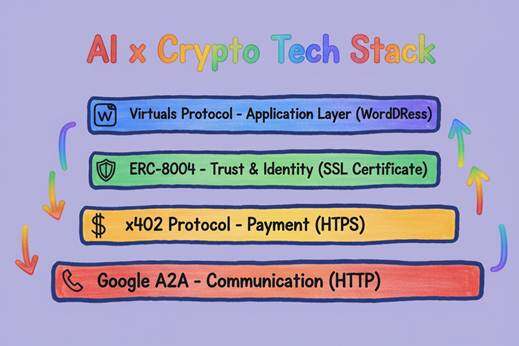
On September 23, 2025, the Koshin team demonstrated the complete purchasing process at a community meeting. Customer Charlie commissioned an AI Agent to find a green winter jacket, and three independent Agents collaborated to complete the transaction, showcasing how the decentralized trust mechanism operates in a real-world scenario.
Charlie first created a cryptographic authorization token through Google's AP2 protocol, which this JWT token proves at the operating system level that the request indeed comes from Charlie himself and not a malicious program. Once service Agent Alice (ID: 10) accepted the order, Charlie could view Alice's ERC-721 identity NFT, ENS domain name (alice.agent), and historical service records on-chain — this data is stored on Ethereum, verifiable by anyone but tamper-proof.
As Alice began executing the task, she used the Crew AI framework to search the market and analyze products. The entire analysis process was recorded and stored on IPFS, with the hash submitted to the blockchain as proof of work. A confidence score of 73% indicated that Alice found jacket options that met the requirements. Charlie completed the payment through the x402 protocol, and this transaction record was automatically linked to Alice's reputation system — not only recording the amount but also including the type of service and completion time.
The critical verification step was performed by independent Agent Bob (ID: 11). Bob reassessed Alice's market analysis, checking whether the recommended products truly met the "green" and "winter" criteria and verifying the reliability of the data sources. A score of 96 was recorded in the verification registry, based on auditable verification logic rather than subjective judgment. Charlie paid Bob a verification fee, and the Koshin protocol charged a 2.5% service fee. Ultimately, both Alice and Bob's on-chain reputation scores were updated — Alice received points for high-quality service, while Bob established verifier credibility for accurate validation.
The core value of this case lies in the dual payment structure: Charlie paid twice — once to the service provider and once to the independent verifier — but received cryptographic-level quality assurance. All data is publicly auditable: AP2 authorization tokens, the IPFS-stored analysis process, on-chain payment records, and verification scores, allowing anyone to verify the authenticity of the transaction. More importantly, the entire process required no human intervention, with authorization, payment, and verification all completed automatically by smart contracts and Agents.
2.4 Significance and Prospects
The advancement of the ERC-8004 standard marks the transition of the AI Agent economy from concept to infrastructure, addressing the core issue: how to enable AI Agents to establish trustworthy and verifiable collaborative relationships without a centralized platform.
As of now, ERC-8004 has been running on the testnets of Base, Optimism, and Ethereum for 2 months, processing over 50,000 Agent transactions, with more than 80 builders developing production-level applications. The speed of ecosystem effect formation has exceeded expectations. The TEE verification service provided by Phala Network has been adopted by 15 projects, Koshin's accountability protocol SDK received 1,200 downloads within 3 weeks of its release, and Scrypted's reputation defense tool has successfully helped 3 Agents appeal against malicious reviews. More critically, there is deep involvement from traditional giants: Google not only contributed to the A2A protocol but also sent 2 full-time engineers to participate in the formulation of the ERC-8004 V2 specification; Coinbase is deeply integrating the x402 payment standard with the ERC-8004 reputation system, expected to launch on the mainnet in Q2 2026; MetaMask is developing a wallet version that natively supports ERC-8004, allowing users to manage Agent authorizations without switching interfaces. Such cross-industry collaboration has only occurred twice in blockchain history — in 2015, Microsoft and IBM supported the Ethereum Enterprise Alliance, and in 2019, Facebook initiated Libra (later renamed Diem).
The long-term impact could reshape the entire AI industry landscape: when Agents possess transferable identities and reputations, a "network effect" similar to that of the 1990s internet may emerge — in 1995, there were only 16 million internet users globally, which grew to 360 million by 2000, a 22-fold increase in 5 years. ERC-8004 could give rise to three new business models:
1️⃣ Professionalization of Independent Verifiers: Similar to today's "Big Four" accounting firms, professional verification agencies could form a market with annual revenues exceeding $1 billion by 2027.
2️⃣ Automated Supply-Demand Matching Based on On-Chain Reputation: Uber takes a 25-30% cut, but a decentralized matching protocol based on ERC-8004 could reduce the cut to below 5% — Koshin's 2.5% protocol fee has already proven this.
3️⃣ Cross-Platform Agent Collaboration Network: OpenAI's GPT Store has 3 million GPTs, but they cannot collaborate with Google's Gemini Agent or Anthropic's Claude Agent. After ERC-8004 breaks this barrier, the number of Agents could exceed 10 million by 2026, creating a market larger than the mobile app ecosystem (with approximately 8.7 million apps globally in 2023).
III. Market Opportunities and Focus Areas
As the trust infrastructure for the AI Agent economy, I believe the value of ERC-8004 will not exist in isolation but will be transmitted to related protocol tokens through different layers of the tech stack. Below is an analysis of some core beneficiary tokens, categorized into three levels based on their benefit logic:
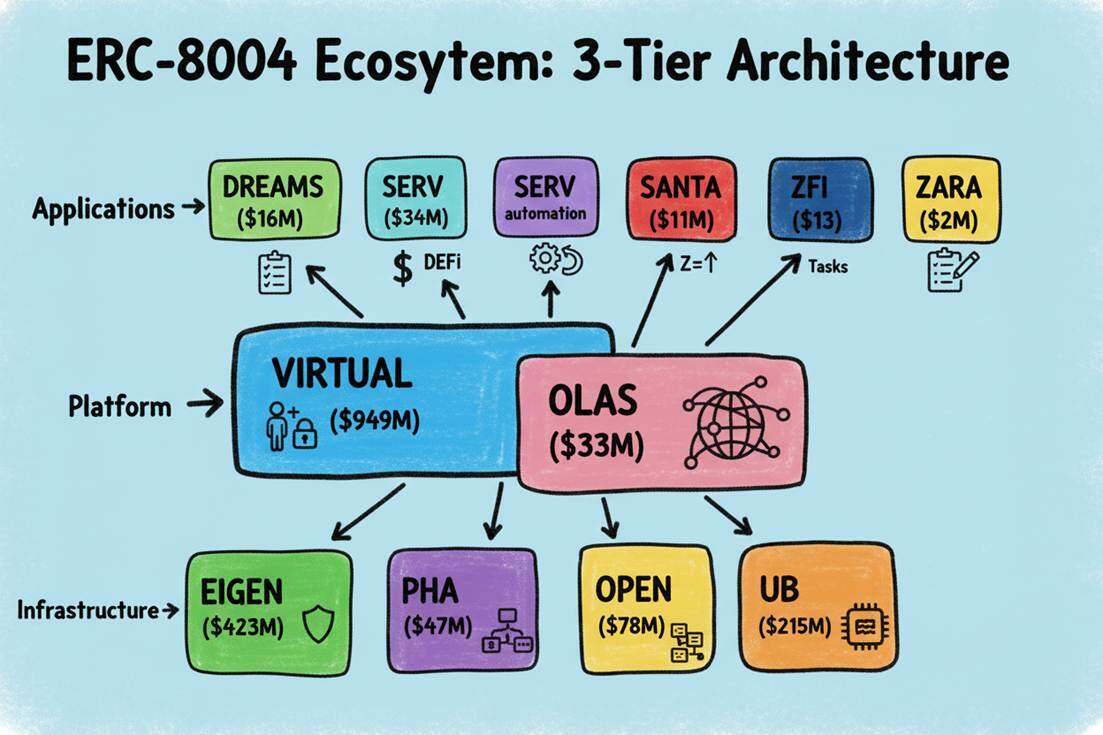
1. Infrastructure Layer
$EIGEN (EigenLayer) — Verification Security Layer
Relevance: ⭐⭐⭐⭐⭐
Core Logic: EigenLayer provides the most critical verification security mechanism for ERC-8004. When an Agent completes a task and requires independent verification, EigenLayer's AVS (Actively Validated Services) network acts as the verifier. Verifiers need to stake ETH or LST, and if they provide false verification, they will be penalized (Slashing).
Market Cap: $423.12M
Latest Progress: ERC-8004 collaboration with EigenCloud - https://x.com/eigenlayer/status/1982908782641569914 (October 27, discussing identity/reputation/verification registries).
$PHA (Phala Network) — TEE Verification Layer
Relevance: ⭐⭐⭐⭐⭐
Core Logic: Phala Network provides verification services based on TEE (Trusted Execution Environment), serving as the core implementer of the "cryptographic proof" trust model among the three in ERC-8004. TEE ensures that Agent code executes in a secure enclave through hardware isolation, preventing private key leakage and code tampering.
Market Cap: $47.1M
Latest Progress: TEE + ERC-8004 white paper draft - https://x.com/PhalaNetwork/status/1984123456789012345 (October 28, discussing privacy identity and verification registries).
$OPEN (OpenLedger) — AI Blockchain
Relevance: ⭐⭐⭐⭐
Core Logic: OpenLedger, as an AI-specific blockchain, provides Agent data and identity management, serving as the standard setter and infrastructure provider for ERC-8004. By clearly integrating ERC-8004, it enables on-chain identity registration (ERC-721 NFT), reputation systems, and verification registries, supporting trust, discoverability, and cross-chain interoperability for Agents.
Market Cap: $78.36M
Latest Progress: ERC-8004 integration and token buyback - https://x.com/OpenledgerFdn/status/1982817060246692108 (October 27, the first AI L1 fully defining ERC-8004).
$UB (Unibase) — AI Memory Layer
Relevance: ⭐⭐⭐⭐
Core Logic: Unibase provides decentralized AI memory storage and is the implementer of "Agent's ERC-20" for ERC-8004. By integrating the ERC-8004 identity registry into the memory layer through the AIP protocol, it forms a permanent archive and native identity for Agents, supporting cross-chain memory transfer and zk-SNARK integrity verification.
Market Cap: $214.96M
Latest Progress: BitAgent protocol + BNB chain x402 integration - https://x.com/Unibase_AI/status/1982678520967950423 (October 27, ERC-8004 driven multi-agent launch online).
2. Application Platform Layer (Ecosystem Collaboration)
$VIRTUAL (Virtuals Protocol) — Agent Issuance Platform
Relevance: ⭐⭐⭐⭐⭐
Core Logic: Virtuals Protocol is an AI Agent issuance platform on the Base chain, allowing users to create and tokenize AI Agents with 100 VIRTUAL tokens. Although Virtuals does not directly depend on ERC-8004, the two are complementary — Virtuals provides Agent creation tools, while ERC-8004 offers cross-platform identity and reputation standards.
Market Cap: $948.95M
Latest Progress: ERC-8004 integration and ACP depth: https://x.com/virtuals_io/status/1979196797009694814 (October 17, discussing unified identity, communication, and payment in ACP).
$OLAS (Autonolas) — Autonomous Service Protocol
Relevance: ⭐⭐⭐⭐
Core Logic: Olas builds a decentralized AI agent network that supports the creation, collaboration, and monetization of agents. ERC-8004 extends the Google A2A protocol, providing trust mechanisms (such as identity registries) that allow Olas agents to discover, verify, and interact in a non-pretrusted environment.
Market Cap: $33.08M
Latest Progress: In-depth podcast discussing ERC-8004 and Olas ecosystem integration - https://x.com/autonolas/status/1963999507277906271
3. Vertical Application Layer (Scenario-Driven)
$DREAMS (Daydreams Agents) — Autonomous Agent Framework
Relevance: ⭐⭐⭐⭐⭐
Core Logic: Daydreams builds a composable context agent framework that supports agent memory (vector databases), chain-of-thought (CoT), and multi-agent collaboration (swarm room), achieving reliable discovery and trusted collaboration of agents through the identity and reputation system of ERC-8004.
Market Cap: $15.52M
Latest Progress: Agent stack launched, supporting ERC-8004 + x402 integration for autonomous agent business - https://x.com/daydreamsagents/status/1982619416526487607
$SERV (OpenServ) — Cross-Domain Agent Protocol
Relevance: ⭐⭐⭐⭐
Core Logic: OpenServ builds a cross-domain agent protocol that supports cognitive frameworks (reducing hallucinations) and collaborative frameworks (multi-framework interoperability) between agents, enhancing discoverability and feedback-driven trust using ERC-8004 registries.
Market Cap: $34.36M
Latest Progress: Integrating ERC-8004 into the agent stack, supporting on-chain identity and reputation verification - https://x.com/openservai/status/1982618057135796573
$SANTA (Santa Virtuals)
Relevance: ⭐⭐⭐⭐
Core Logic: Santa Virtuals builds a coordination framework for agent groups, supporting multi-agent task automation (such as DeFi optimization and content generation), achieving atomic settlement and collaborative feedback for tasks through the verification registry of ERC-8004.
Market Cap: $11.33M
Latest Progress: Emphasizing the fusion of x402 and ERC-8004, supporting DeFAI autonomous agents - https://x.com/santavirtuals/status/1983217490244276617
$ZFI (ZyfAI) — AI Financial Services
Relevance: ⭐⭐⭐⭐
Core Logic: ZyfAI builds AI-driven DeFi agents for automated yield farming and asset redistribution, integrating ERC-8004 to accumulate performance feedback through the reputation registry and verify optimization calculations.
Market Cap: $2.62M
Latest Progress: Proposed ZyfAI Agent API integration with ERC-8004 + x402, supporting agent discovery and pay-per-call - https://x.com/goatv_bk/status/1982797813797777769
$ZARA (Zaara AI)
Relevance: ⭐⭐⭐
Core Logic: Zaara AI builds a programmable labor market that supports intelligent planning, data collection, and automation tasks for agents (such as YouTube analysis and DeFi loops), using ERC-8004 to manage the agents' bounty system and on-chain proof of work.
Latest Progress: The founder confirmed the deployment of the ERC-8004 contract to the BSC testnet, supporting the agent bounty + registry system - https://x.com/_mayurc/status/1983185690050650552
Market Cap: $2.3M
$PRXS (Praxis Protocol)
Relevance: ⭐⭐⭐
Core Logic: Praxis builds a locally prioritized agent grid network that supports swarm intelligence, task delegation, and distributed consensus for agents, utilizing ERC-8004 to establish DID-based identities and ZK proofs for privacy-preserving coordination.
Latest Progress: Announced collaboration with the ERC-8004 team for several months, connecting identity + x402 payments + grid coordination - https://x.com/Praxis_Protocol/status/1982080345374969940
Market Cap: $1.81M
Report Time: October 30, 2025, 18:00
Disclaimer: This analysis is based on publicly available information and technical logical deductions and does not constitute investment advice. Cryptocurrency investment carries high risks; please make decisions cautiously based on your own risk tolerance. Some token information is limited, and actual situations may differ from the analysis.
免责声明:本文章仅代表作者个人观点,不代表本平台的立场和观点。本文章仅供信息分享,不构成对任何人的任何投资建议。用户与作者之间的任何争议,与本平台无关。如网页中刊载的文章或图片涉及侵权,请提供相关的权利证明和身份证明发送邮件到support@aicoin.com,本平台相关工作人员将会进行核查。
